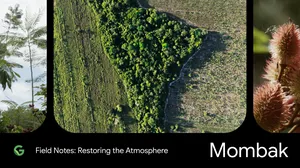Chasing Coral on Google Earth

Editor’s Note: Richard Vevers, Founder and CEO at the Ocean Agency, talks about his quest to protect our oceans and the underwater journey with Street View that led to “Chasing Coral,” a new Netflix documentary.
I am floating above a graveyard, millions of tiny skeletons below me. I am stunned, I am silent. I am witnessing a tragedy in progress. My camera clicks and whirrs, capturing a 360-degree picture of the devastation.
The graveyard was once a thriving coral reef, one of our planet’s most gorgeous and awe-inspiring marvels and home to thousands of species. Colorful corals growing in all shapes and sizes, clownfish peeking out of every anemone. Up above, manta rays and turtles swam in lazy circles, scattering the great glittering schools of tiny blue fish.
What happened?
That’s the question “Chasing Coral” seeks to answer. The film, a Netflix original documentary released today, follows my crew of divers, photographers, and scientists on our quest to reveal what is killing our oceans … and how we can stop it.
“Chasing Coral” was born from a simple idea: If we could give people a personal, up-close look at how their oceans are being destroyed, they would want to protect them. For the past five years, we’ve been working with Google to make this happen. We created Underwater Street View, which lets people take virtual dives in some of the world’s most beautiful coral reefs. Now with Google Earth, you can splash around in the sparkling waters of a coral reef without even leaving the house.
From there, we set out to show people the great beauty of our coral reefs, as well as the terrible danger that threatens their existence. By collecting Underwater Street View, we found undeniable proof of climate change destruction in the ocean. Documented so spectacularly by Jeff Orlowski in “Chasing Coral,” the warning signs are unmistakable. The countdown has already begun.
Fortunately, it’s not all bad news. Some coral reefs are less vulnerable to the rising water temperatures that have already killed so many others. This year we started the 50 Reefs to find these resilient reefs—the ones that with the greatest capacity to repopulate other reefs—so that we can bolster our efforts to protect the corals that still remain. In October we’ll announce a list of the reefs that could be pivotal for the future of the ocean, a list that can catalyze global action.
The release of “Chasing Coral” and the launch of 50 Reefs share two critical ideas: what happens to coral reefs affects every single person on Earth (even if they’re thousands of miles from the nearest coast); and, if we want to save the reefs, we need everyone to pitch in now.
There’s already been an outpouring of support for our work from philanthropic foundations like Bloomberg Philanthropies, The Tiffany & Co. Foundation, and Paul G. Allen Philanthropies. With their help, we’ve been able to launch an initiative that could make all the difference. We’ve got a lot of work yet to do, but we’re off to a promising start.
Now that “Chasing Coral” is available to stream on Netflix, I hope that you’ll watch it. I hope that you’ll feel the same wonder that I felt as a child when I slipped beneath the waves for the first time and found myself in an underwater paradise of beauty and color. I hope the film will both sadden and strengthen you. I hope you will spread the word.
Most of all, though, I hope you join the fight to save coral reefs. Please follow our story on Google Earth and support us at 50Reefs.org.






